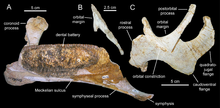You can help expand this article with text translated from the corresponding article in Polish. (April 2020) Click for important translation instructions.
|
| Blasisaurus Temporal range: Late Cretaceous, 66 Ma PreꞒ Ꞓ O S D C P T J K Pg N ↓ | |
|---|---|

| |
| Skull fossils | |
| Scientific classification | |
| Domain: | Eukaryota |
| Kingdom: | Animalia |
| Phylum: | Chordata |
| Clade: | Dinosauria |
| Clade: | †Ornithischia |
| Clade: | †Neornithischia |
| Clade: | †Ornithopoda |
| Family: | †Hadrosauridae |
| Subfamily: | †Lambeosaurinae |
| Tribe: | †Arenysaurini |
| Genus: | †Blasisaurus Cruzado-Caballero et al., 2010 |
| Type species | |
| †Blasisaurus canudoi Cruzado-Caballero et al., 2010 | |
Blasisaurus is a genus of lambeosaurine hadrosaurid dinosaur from the Late Cretaceous. It is known from a partial skull and skeleton found in late Maastrichtian-age rocks of Spain. The type species is Blasisaurus canudoi, described in 2010 by Penélope Cruzado-Caballero, Xabier Pereda-Suberbiola and José Ignacio Ruiz-Omeñaca, a group of researchers from Spain.
Naming and discovery
The generic name refers to the Blasi 1 site where the fossil was found. The specific epithet honours paleontologist José Ignacio Canudo. The holotype, MPZ99/667, is housed in Huesca. It was found in a layer of the Arén Formation dating from the upper Maastrichtian, about 66 million years ago. It consists of a skull with fragmentary lower jaws.
Description

Blasisaurus was a medium-sized ornithopod. Its describers identified two distinct features: the cheekbone has a rear projection with a hook-shaped upper edge and the lower sleep window is narrow and D-shaped. From the same formation is Arenysaurus, a related species. They are distinguished by the shape of the teeth and missing secondary ridges. Blasisaurus also differs from Koutalisaurus by a downward bent front edge of the lower jaw.
Phylogeny
Blasisaurus' discoverers performed an exact cladistic analysis to determine its phylogenetic position, which placed it as the sister taxon to Arenysaurus. Together they form a tribe, the Arenysaurini, that is more derived than Tsintaosaurus and Jaxartosaurus. Blasisaurus confirmed the hypothesis that, in the Late Cretaceous, different hadrosaurids from Asia and Europe migrated across land bridges. Where in Lambeosaurinae Blasisaurus and Arenysaurus belong is disputed. Some put them in the tribe Lambeosaurini at the base of the lambeosaurin-parasaurolophin split, some in Parasaurolophini. Below is the most recent cladogram including Blasisaurus and Arenysaurus, published by Penélope Cruzado-Caballero et al. in 2013:
| Hadrosauridae |
| ||||||||||||||||||||||||||||||||||||||||||||||||||||||||||||||||||||||||||||||||||||||||||||||||||||||
See also
References
- ^ Cruzado-Caballero, Penélope; Xabier Pereda-Suberbiola; José Ignacio Ruiz-Omeñaca (2010). "Blasisaurus canudoi gen. et sp. nov., a new lambeosaurine dinosaur (Hadrosauridae) from the Latest Cretaceous of Arén (Huesca, Spain)". Canadian Journal of Earth Sciences. 47 (12): 1507–1517. Bibcode:2010CaJES..47.1507S. doi:10.1139/E10-081.
- Prieto-Márquez, A.; Dalla Vecchia, F. M.; Gaete, R.; Galobart, À. (2013). Dodson, Peter (ed.). "Diversity, Relationships, and Biogeography of the Lambeosaurine Dinosaurs from the European Archipelago, with Description of the New Aralosaurin Canardia garonnensis". PLOS ONE. 8 (7): e69835. Bibcode:2013PLoSO...869835P. doi:10.1371/journal.pone.0069835. PMC 3724916. PMID 23922815.
- ^ Cruzado-Caballero, P. L.; Canudo, J. I.; Moreno-Azanza, M.; Ruiz-Omeñaca, J. I. (2013). "New material and phylogenetic position of Arenysaurus ardevoli, a lambeosaurine dinosaur from the late Maastrichtian of Arén (northern Spain)". Journal of Vertebrate Paleontology. 33 (6): 1367–1384. Bibcode:2013JVPal..33.1367C. doi:10.1080/02724634.2013.772061. S2CID 86453373.
| Taxon identifiers | |
|---|---|
| Blasisaurus | |
